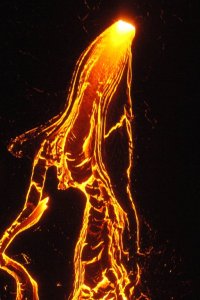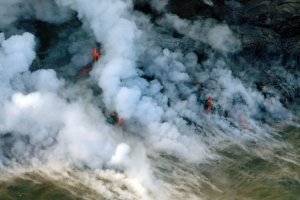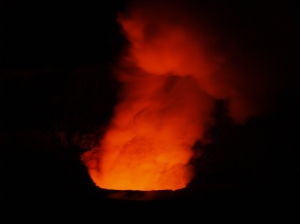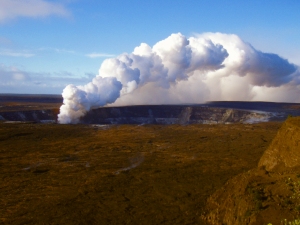
KILAUEA VOLCANO (CAVW#1302-01-)
19.42°N 155.29°W, Summit Elevation 4091 ft (1247 m)
Volcano Alert Level: WATCH
Aviation Color Code: ORANGE
This report on the status of Kilauea volcanic activity, in addition to maps, photos, and webcam images (available using the menu bar above), was prepared by the USGS Hawaiian Volcano Observatory (HVO). Hawai`i Volcanoes National Park status can be found at http://www.nps.gov/havo/ or 985-6000. Hawai`i County Viewing Area status can be found at 961-8093.
Activity Summary for last 24 hours: The final inflation portion of a DI tilt event is in progress. Sulfur dioxide emission rates from the Halema`uma`u and the Pu`u `O`o vents remain high although the emissions from Pu`u `O`o have been decreasing since August. Tephra production from the Halema`uma`u vent remains small. At the east rift eruption site, the flow of lava has paused.
Last 24 hours at Kilauea summit: Weak winds produced poor air quality during most of the last 24 hours. Vent glow was too weak to be recorded by the webcam overnight. This morning, winds above 300 m (1,000 ft) are moving the gas plume to the southwest; winds closer to the ground are weaker resulting in voggy air. GOES-WEST imagery shows the plume moving southwest inland of the coast.
Small amounts of tephra continued to be produced, the collections continue to consistent mostly of glassy spatter. In addition to sounds resembling distant surf, rock falls and rolls could also be made out from the vent.
Sulfur dioxide emission rates remain elevated and variable. The most recent average measurement was 500 tonnes/day on October 24, compared to the 2003-2007 average rate of 140 tonnes/day.
The network of tiltmeters within Kilauea caldera recorded the inflation portion of the ongoing DI tilt event starting at about 2 am. The GPS receiver networks (less sensitive than tiltmeters) recorded small changes but no significant extension or contraction over the past two weeks.
Seismic activity continued to be focused on the south caldera; tremor levels dropped with the start of inflation. A total of 17 earthquakes were located beneath Kilauea or nearby, including 5 beneath the south caldera and none on south flank faults, with the number of RB2S2BL earthquakes increasing to around 50/day.
Last 24 hours at the middle east rift zone vents and flow field: Magma continues to degas through Pu`u `O`o Crater. The most recent sulfur dioxide measurement of 1,100 tonnes/day on October 24 is below the 2005-2007 average of about 2,000 tonnes/day for this vent; Pu`u `O`o emission rates have been slowly declining since early August. No incandescence was observed within the crater overnight.
Pu`u `O`o continues to deflate/collapse. The tiltmeter on the north side of Pu`u `O`o recorded no change in tilt since noon yesterday; the Pu`u `O`o tiltmeter has not yet responded to the DI inflation in progress at the summit. GPS stations spanning the crater (less sensitive than tiltmeters) recorded weak contraction across the crater. Seismic tremor levels near Pu`u `O`o and the TEB vent remain at low values and still haven't responded to the ongoing DI tilt event.
Lava from the TEB vent and the rootless shield complex has paused. The ocean entry plume was very small and only intermittently active yesterday through last night. Incandescence was seen high on the pali above Royal Gardens and from the TEB vent overnight and this morning. GOES-WEST thermal anomalies continued to weaken overnight suggesting that surface flows are no longer active. This morning, CD officials report no active ocean entry.

For more information on visiting Hawaii in general or touring the Big Island in particular, go to www.tourguidehawaii.com and www.lovingthebigisland.wordpress.com. For video of the eruptions in Hawaii volcanoes national Park, go here, here and here.













